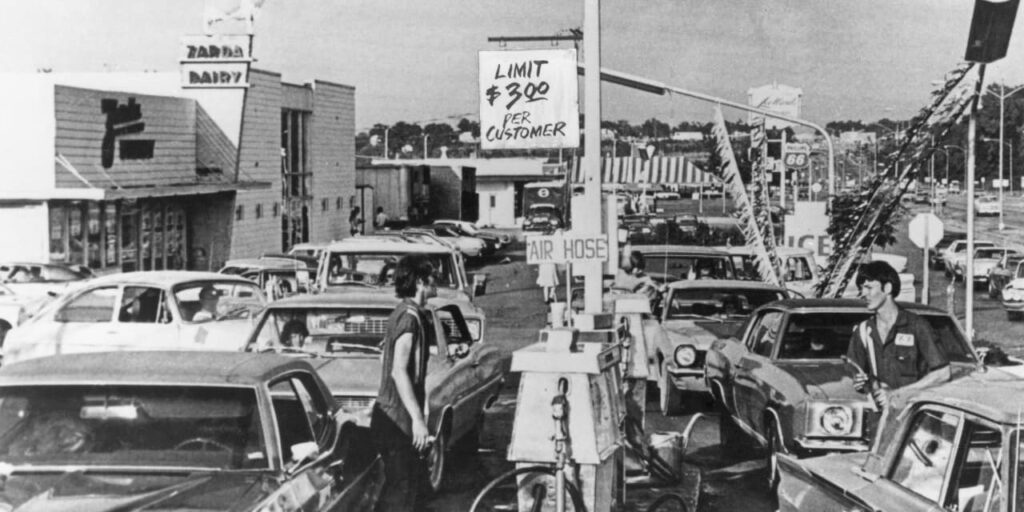The symbolism of Hamas attacking Israel on Oct. 7, one day after the 50th anniversary of the Yom Kippur War, was impossible to miss. So was the rise in oil prices.
But a half-century on, a lot is different, too. Long lines of cars queuing up for gasoline probably aren’t in our future this time. The U.S. and the world are far less reliant on oil, especially OPEC oil, than they were in 1973.
“The stock market had a lot to deal with,” Barron’s Lawrence A. Armour wrote Oct. 15, 1973, nine days after Egypt and Syria launched a surprise invasion of Israel.
The Cold War had just heated up, The U.S. was Israel’s top backer, while the U.S.S.R. supported the Arabs. Initial successes for Egypt and Syria were soon reversed as Israel recovered from its poor preparation, and on Oct. 25 a U.N.-brokered cease-fire was implemented.
But though the military conflict ended, an economic war was launched on Oct. 22 when Arab states led by Saudi Arabia enacted an oil boycott of the U.S. and allies for their support of Israel. Crude prices would triple within six months as the U.S., once the world’s leading oil producer, paid the price for growing dependence on OPEC imports.
On Nov. 7, the Nixon administration rolled out a new initiative: “Project Independence,” designed by Federal Reserve Chairman Arthur F. Burns to free the U.S. from “Arab blackmailing sheiks,” as he wrote in his personal diary.
Project Independence had little immediate effect (besides angering drivers with a hated 55-mph speed limit). But it did plant the seeds for eventual U.S. energy independence.
Meanwhile, U.S. gasoline prices jumped, and supplies tightened to the point that service stations ran out of fuel. Hours were curtailed, and lines of cars waiting for gas became a common sight.
Connecticut’s Hartford Courant wrote on Feb. 17, 1974, how one local town formed an Emergency Energy Committee to “figure out some way to relieve traffic-line situations on Rt. 4,” where vehicles were “often backed up a mile in a gasoline line.”
Government attempts to address the issue weren’t helping.
“The lines were as long as ever today as California Gov. Ronald Reagan’s ‘odd-even’ gasoline marketing plan went into effect,” the Oakland Tribune reported on March 1, 1974. Drivers found another surprise when they got to the pumps, the Trib wrote: “an increase in the price of gas.”
Nerves were fraying.
“Gas prices are ridiculous,” a local man filling his tank with 53.9 cent per gallon gas told New Mexico’s Albuquerque Tribune on March 5, 1974. “I think the shortage was contrived to drive up prices, and I’m fed up with it.”
The embargo ended in March 1974, but low gas prices didn’t return, and America suffered through another oil crisis in 1979. All this took place as the U.S. was already mired in stagflation, a period of low growth beset with high unemployment and rising inflation.
Yet, stagflation would be beaten, and America would break its dependence on OPEC crude. The fracking revolution, which allowed oil and gas to be extracted from vast new areas of the U.S., rejuvenated the energy industry, as have renewable energy sources.
In 1973, 46% of U.S. energy consumption came from petroleum, according to the U.S. Energy Information Administration. Coal provided 22%, natural gas 21% and renewables 5%. In 2022, petroleum’s portion was down to 36% and coal’s to 10%, while natural gas (33%) and renewables (13%) both rose.
At the same time, the U.S. economy became more energy efficient. Gasoline-powered cars in 2022 got 25.7 mpg, compared with 13.5 mpg in 1973, according to the EIA. And homes built after 2000 use 21% less energy than older houses.
Today, the U.S. once again is the world’s top petroleum-producing nation, rolling out 20.3 million barrels a day while consuming 19.9 million barrels, according to the EIA. We achieved Arthur Burns’ energy independence, after all.
That doesn’t mean the price of oil won’t spike painfully high again. Like peace in the Middle East, the dream of cheap energy always seems just out of reach.
Write to [email protected]
Read the full article here













